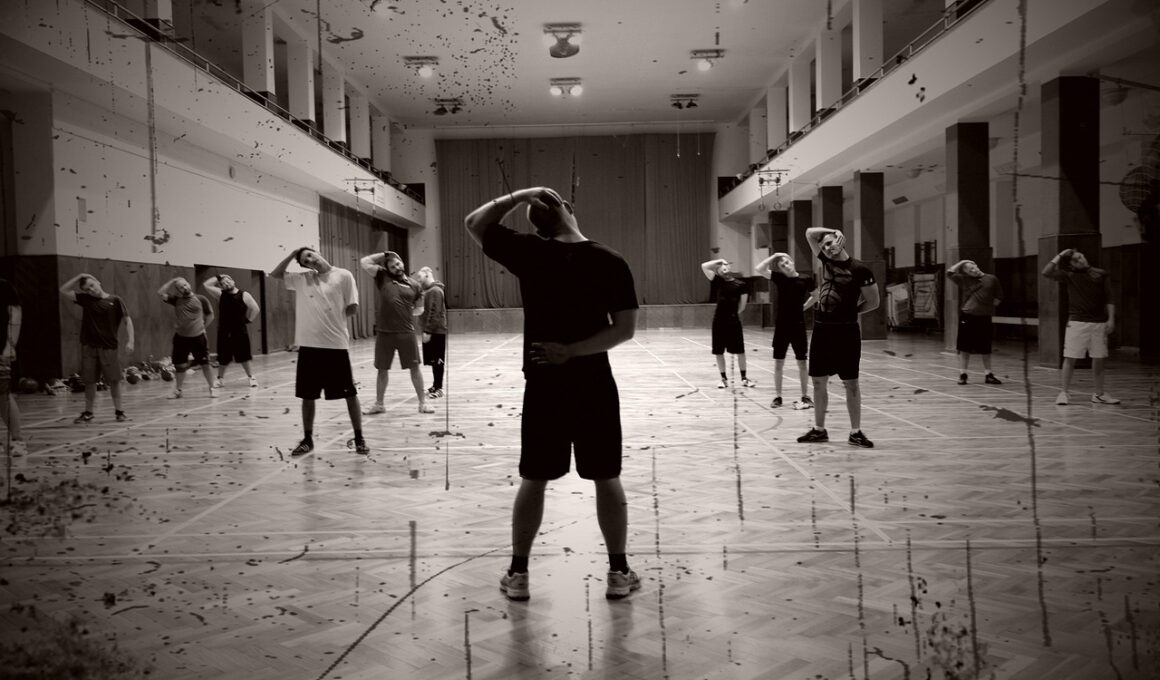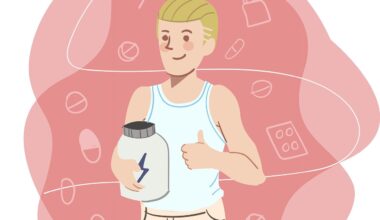Warm-up and Cool-down Practices in Different Athletic Disciplines
In any athletic discipline, preparing the body for physical activity through proper warm-up techniques is essential. Athletes, no matter their sport, should engage in activities that raise their heart rates and increase blood flow to muscles. Dynamic stretches, such as leg swings and arm circles, are highly recommended as they help improve flexibility and range of motion. A general warm-up session might include jogging or skipping for a few minutes. Specific sports may require tailored warm-up routines; for example, sprinters often perform explosive drills that mimic sprinting movements, while swimmers may focus on shoulder mobility. Furthermore, sports like gymnastics demand a thorough warm-up to ensure that athletes prevent injuries during complex routines. Engaging in fundamental physiological principles through proper warm-up can make the difference between optimal performance and potential setbacks. Therefore, athletes must prioritize this aspect of their training and integrate effective warm-up methods into their regimen. These practices can prepare both the body and mind for the challenges ahead, ultimately enhancing overall athletic performance.
The Importance of Cool-down in Athletic Training
While warm-up practices are critical for performance, cool-down routines play an equally vital role in recovery. The cool-down process allows an athlete’s heart rate to gradually return to resting levels, helping prevent injuries and reduce muscle soreness after intense physical exertion. Engaging in low-intensity activities such as light jogging, walking, or biking can effectively help to facilitate this transition. Following these activities, static stretching becomes essential, targeting major muscle groups that were used during the workout. Stretching improves flexibility and decreases muscle tension, making recovery smoother and more effective. Additionally, cool-down practices are psychologically beneficial, providing athletes with a moment to reflect on their performance and mentally detach from the intensity of competition. It is also a perfect time for athletes to hydrate and replenish lost nutrients. By incorporating a dedicated cool-down session into their training programs, athletes ensure they’re not only enhancing physical recovery but also supporting future training sessions. This routine ultimately contributes significantly to long-term athletic performance and longevity in their respective sports.
Different sports require unique warm-up and cool-down strategies tailored to their demands. For instance, team sports like soccer and basketball benefit from dynamic warm-ups that involve movements mimicking specific actions encountered during games. Drills involving planned movements, such as lateral shuffles and high-knees, should be incorporated. Conversely, endurance sports like running or cycling might include longer warm-ups focused more on aerobic activity to prepare the cardiovascular system. The subsequent cool-down should consist of easy-paced activities preceding static stretches aimed at toning down the muscles involved. Weightlifting specifically highlights the need for thorough warm-up activities focused on the joints and muscle groups targeted in a session. Using light weights for higher repetitions can effectively prepare the body. Sport-specific techniques enhance the warm-up/cool-down effectiveness, addressing factors like muscle adaptation, joint mobility, and overall athlete readiness. Ultimately, a clear understanding of the unique needs specific to a sport fosters improved overall health, performance level, and injury prevention. Therefore, training-specific protocols aid in realizing optimal athletic performance.
Warm-up Techniques for Individual Sports
Individual sports, such as tennis and swimming, require warm-up techniques specifically designed for their demands. Tennis players benefit from a warm-up focused on shoulder and wrist mobility, essential for powerful strokes. Dynamic exercises like arm swings and the use of resistance bands are essential components of this process. Moreover, practicing footwork during a warm-up helps with agility on the court. Swimmers, on the other hand, often warm up through in-water activities like easy swimming or specific strokes that enhance shoulder range and coordination. This ensures they are prepared to exert their maximum effort during competition effectively. The warm-up for individual sports should not only prepare physically but also mentally, helping athletes focus and strategize their upcoming performance. Additionally, mental visualization techniques during warm-ups can enhance concentration and competition readiness. In individual sports, where success heavily relies on personal performance, adopting tailored warm-up routines can significantly impact results and overall experience. Athletes should prioritize mastering these warm-up exercises to enjoy better performance on competition day.
The cool-down phase in individual sports is equally essential, focusing on gradual recovery and muscle care. For tennis players, cool-down should involve light stretching of the arms, legs, and back, aimed at easing muscle tension after rigorous activity. Joints can easily become painful after intense matches; thus, incorporating cooldown practices is crucial. Swimmers can benefit from a similar approach through gentle swimming or floating after events. Light swimming can help clear lactic acid, promoting recovery while offering a soothing transition. Physiological benefits extend to cardiovascular stabilization and muscle relaxation, allowing athletes to regain optimal heart rates and prevent injuries. Equally important is hydration and nutrient replenishment, which significantly enhances recovery. Managing sweat loss through proper hydration methods is fundamental in sports like tennis, where players endure prolonged matches. By adhering to effective cooldown practices, athletes can enhance their recovery, paving the way for continued improvement and performance enhancements while lowering injury risk. Cultivating habits that include these sequences will support athletes through their training regimes and competitive experiences.
Warm-up and Cool-down in Team Sports
In the context of team sports, warm-up and cool-down protocols become collaborative, enhancing camaraderie and teamwork alongside physical preparation. Warm-ups in sports like football, basketball, or hockey often consist of drills that engage the entire team, ensuring athletes develop group dynamics before matches. These warm-ups can include light passing drills, dynamic stretching, and sport-specific movements tailored to the game. Team cohesion can improve participant focus and subsequently prepare the mind for the oncoming competition challenge. Following the match, cool-down activities require collective participation in activities such as light jogging and group stretching sessions. This fosters teamwork while addressing individual recovery needs. Stretching after athletic activities reduces muscle tightness and potentially enhances performance for the next session. Also, conducting post-match debriefing sessions alongside cooldown exercises can aid athletes in reflecting on their performance collaboratively. Thus, team sport warm-ups and cooldowns serve to bolster physical preparation while enhancing social bonds among players, rendering the experience not only about performance improvements but also about collective enjoyment.
The effectiveness of warm-up and cool-down routines can vary based on individual athletes’ preferences as well as the sports they participate in. While some athletes thrive under structured warm-up techniques, others may prefer flexibility in their approach to warming up or cooling down. Therefore, keeping a balance between individual and team strategies is essential. Coaches should involve athletes in creating these routines, ensuring they feel comfortable and confident. Empowering athletes to adopt practices that resonate with them leads to enhanced focus and motivation. Also, athletes must be educated on the potential implications of neglecting warm-up and cool-down phases. It is crucial to understand how these practices contribute significantly to the overall athletic experience, both in terms of enjoyment and performance. Moreover, monitoring factors like fatigue and muscle soreness post-activity leads to adjustments in warm-up or cool-down practices for future events. Keeping a varied and dynamic mindset when approaching these phases ensures athletes continually advance while supporting their health journey. Ultimately, the synergy between preparation and recovery might significantly define athletic success.
The integration of technology into warm-up and cool-down practices can revolutionize how athletes prepare for training and competition. Wearable devices like fitness trackers can measure heart rates, providing real-time feedback during warm-ups to ensure athletes elevate their intensity to optimal levels. Additionally, applications designed for athletes can offer personalized warm-up and cool-down routines based on individual performance metrics. These tools provide athletes and coaches with comprehensive data, enabling tailored adjustments contributing to improved results. Virtual coaching platforms can further enhance these practices by offering guided warm-up sessions, ensuring athletes engage in correct techniques. Moreover, communities of athletes within these apps can share their experiences, affirming or adjusting routines based on collective insights. Integrating innovation in these phases impacts more than just performance; it allows for easier injury prevention through tailored recommendations. Combining traditional warm-up and cool-down knowledge with advanced technology creates sophisticated training strategies that can lead to higher levels of performance success. As athletes increasingly embrace these technological advancements, the future of warm-up and cool-down practices looks promising.


